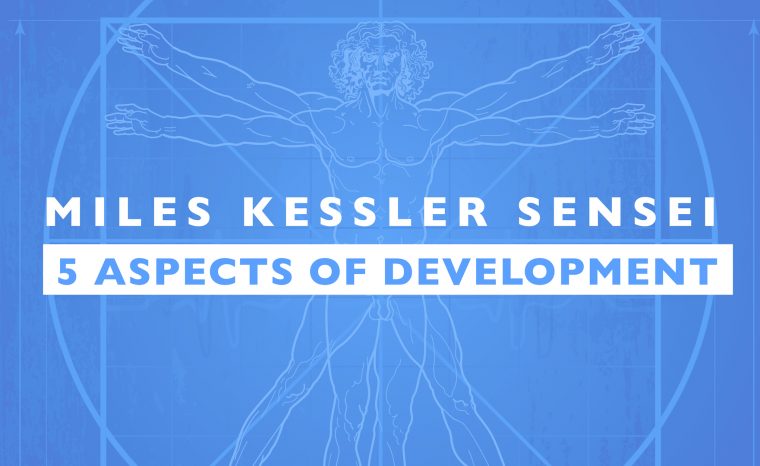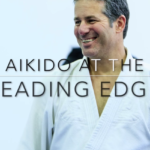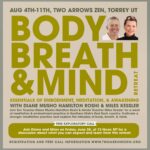Ever wonder if you are developing in your practice? How do you know? With all of the ups and downs, wrong turns, pitfalls, backslides, and seemingly endless plateaus, development can be quite a messy affair. It will not always be clear to you if you are developing, or not. Wouldn’t it be nice if there was a blueprint for development? A checklist of aspects that if you could cover them all, then you could rest assured that development is happening. As it turns out such a blueprint exists. It is called “The 5 Aspects Of Development” and when you cover all of these aspects to a satisfactory level, development just happens.

This past September 2017, I launched an online course called the “Aikido At The Leading Edge Masterclass” with 12 of the Aikido world’s most inspiring teachers. I opened this course with an introductory session on “The 5 Aspects Of Development”. This session was recorded and I’m happy to share the recording of this teaching with you all here at the beginning of the year.
In this video, I elaborate on the 5 aspects of learning; namely 1) Intention 2) Attention 3) Repetition 4) Instruction 5) Reflection.
(if your more of an audio/visual type, then you may want to just jump down to the video at the bottom of this post)
1) Intention
Everything begins with intention. Without it the other 4 aspects of learning never fully manifest. Intention creates the context within which your practice takes place. Your intention is like a northern star that always guides you forward. It is the very mechanism that holds you steady through the inevitable ups and downs of your practice, leading you through your challenges and towards your goals.
So setting your intention from the outset is essential to all learning. Here are a few ways to set your intention:
- Intentional mind: Having an intentional mind means that you prioritize your thoughts, your interests, and your values towards the same goal. You recognize that there is a potential waiting for you in your future and you make a clear decision to work towards it.
- Intentional space: If your intentional mind happens in your interior world, then the intentional space is about your exteriors. The way you set up your external learning space has a direct impact on how you develop. My meditation teacher Sayadaw U Pandita reminded us yogis that “a neat and orderly environment, refects and neat and orderly mind”. Tidying and organizing you learning environment goes a long way in helping to focus on the practice at hand. Much like we do in the dojo.
- Intentional community: This refers to the Sangha. A practice community that in one way or another puts awareness, learning, and development in the center of their context. It is like an “awareness house of mirrors” where your highest aspirations, as well as your unresolved shadows are constantly relfected to you. Perhaps next to a teacher, you will find no greater external support for your practice like an intentional community.
2) Attention
The common thread that runs through all developmental practices is attention. This is your basic awareness training or mindfulness. Every step on the developmental path of practice is a step of attention, awareness, and mindfulness. With it, development just unfolds. Without it, development stagnates.
Here are some basic ways we pay attention:
- Basic Awareness: There is nothing more natural in your experience than the basic awareness. But even though basic awareness is natural, the minds tendency to drift off and daydream, to dwell on the past, to think about the future, or fantasize has a lifetime of momentum. But development can only happen when we are in the present moment so it is essential that we train our minds to return to the present moment with a basic awareness practice.
- Mindfulness: The Buddha said, “mindfulness is helpful in all things.” This is an absolute statement that applies to all time, in all places, and through all circumstances. The Buddha’s words point to the basic fact that the practice of mindfulness is beneficial to anyone who practices it. When ever, where ever, and how ever, mindfulness is just good.
- Centering: The practice of “centering” in Aikido is how we engage this developmental aspect of attention through the body. When you practice centering not only are we training our attention, but we anchor this training in your body. This is particularly beneficial in Aikido because our main vehicle of practice is the body and a good centering practice is the embodiment of our attention training.
3) Repetition
One way to look at development is when you transform temporary states into permanent traits. This means that when you create the ability to learn a new skill, or the capacity to take a new perspective, it is only the first step in your development. You will need to repeatedly practice your new skill or perspective in order for it to become a permanent expression of who you are. Here are some ways repetition helps you transform your temporary states into permanent traits:
- Kata: The word “Kata” come out of Japanese Martial arts (and non-martial arts) and means “form.” The practice of “kata” is the highly formalized and continuous repetition of a set of patterns or movements. With every repetition the form becomes more shaped, the shape becomes sharper, and the sharpness becomes more polished. Ultimately the repetition practice of your “kata”, or external form becomes internalized. At this point, you no longer “need” the repetition practice because your form has become a natural expression of who you are.
- Creating Good Habits: One reason you don’t develop is because of the bad habits that hold you back. The conscious practice of repetition is the antidote for your ingrained bad habits and the perfect way to get you established in a new set of good habits.
- Practice makes perfect?: The old saying goes “practice makes perfect.” Well, it’s also true that practice makes permanent. If you are simply blindly repeating forms and practices without attention, then there is a very good chance that you will be developing bad habits. If your “repetition” training is not practiced together with the former aspect of “attention” then you can be sure that your practice will stagnate and lead you towards a developmental dead end.
4) Instruction
Repetition alone is not enough. It is essential that you also have an external eye that observes you while you are repeating the practice. This can be a teacher, a mentor, coach, etc., who observes us from the outside and gives you guidance in the repetition of your practice. Instruction is a living feedback loop that helps you to assess, adjust and fine-tune your practice in a way that makes it progressively more effective. There is no way to make one’s development go faster, but wise instruction will keep you wasting time as you navigate the minefield of pitfalls, wrong turns and dead ends in your practice. Here are two essential ways that instruction catalyze your in practice:
- Instruction As Support: An effective developmental process is not always pleasant. Instruction that is supportive will hold you during the inevitable challenges of your practice. A teacher, mentor, or guide who is supportive will give you reassurance during those challenges and will let you know that you are not alone.
- Instruction As Challenge: When difficulties inevitably arise in practice it is totally natural to pull back and do anything you can to avoid the challenge. Instruction as challenge always reflects to you that your greater potential is waiting for you on the other side of your comfort zone and that only you can take the necessary steps. Instruction as challenge always reminds you that you CAN do it.
5) Reflection
Reflection is the glue that holds the whole developmental process together. You can have all 4 of the previous aspects in place but without reflection, the development does not completely come together. But when you take a few moments to step back from the practice and look at how the whole process unfolded, you will gain a deeper understanding and ownership of the development.
Philosopher Soren Kierkegaard said, “we live forward, but we understand backward.” Life is constantly presenting us with lessons, but we can only truly learn these lesson if we reflect on our experiences and understand their reason for our loves. Reflection is a whole practice in and of itself, and here are just a few ways that you can do that practice:
- Journaling: This is a wonderful way to take your inner experience and express it in the outer world. Journaling helps you to take the process that you have been through and begin to articulate it in a personal space. Writing down your process helps you to get clarity on how far you’ve come, where you are at, and where your development can still go.
- Dialogue: There is no better reflection practice than dialoguing with another. This is the practice of sharing your interior with another person who is fully present as a witness to your process. Reflection through dialogue is perhaps the best “bridging practice” that allows you express your newly developed perspective with others in the world. It is the key to integrating your internal experience with your external life.
- From Map to Territory: One way to look at reflection that you step back and compare how the theory of the practice relates to your experience of the practice. A theory is like a map. It will explain the reason for the practice, how to do the practice, the challenges of the practice, and the ultimate goal of the practice. Which is all fine and dandy, but it means nothing as long as it remains theoretical. Practice, on the other hand, is compared to the territory. This is where you put down your map and walk the territory. A good reflection practice will help you to understand how the map and the territory relate. You will create a synchronicity where your practical experience and your theoretical understanding come together in the expression of wisdom
These “5 Aspects Of Development” can be seen as a linear process that you move through stage by stage. With a more mature experience, you will realize that these aspects are more like a cycle that you are constantly rotating through in your practice. Either way, you can be sure that if you are consciously engaging these 5 aspects, then you will continue to grow. And whether it looks like it or not, you can be sure that development is just happening.
Question: How do you relate these 5 aspects of development to your practice? Join the conversation and leave your comments below!
“The 5 Aspects Of Development” – From The Aikido At The Leading Masterclass, recorded on Aug. 27th, 2017.
Join the conversation and leave your comments below!






Please note: I reserve the right to delete comments that are offensive or off-topic.